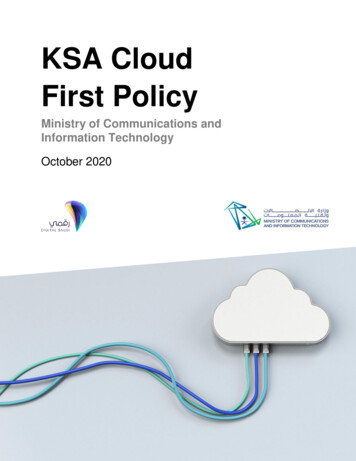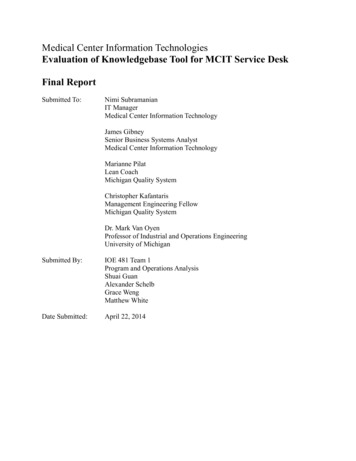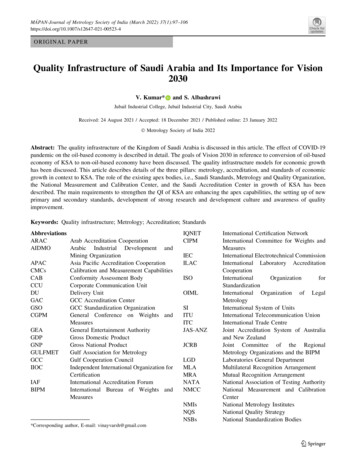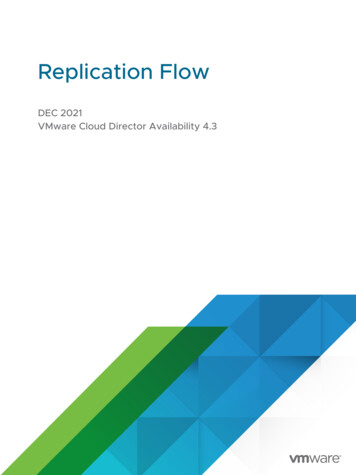
Transcription
KSA CloudFirst PolicyMinistry of Communications andInformation TechnologyOctober 20200
Table of ContentsExecutive summary2Purpose of this document2Overview of Cloud Computing3Key characteristics of Cloud computing3Service Models3Deployment Models5Introduction to Cloud First Policy7How Cloud computing helps the public sector7Implementation of the Cloud First Policy and its benefits9Considerations for Cloud First Policy10KSA’s Cloud First Policy11Purpose of the policy11Scope of the policy11Policy’s Guidelines11Governance Structure15Appendix18List of definitions18List of abbreviations191
Executive summary For any new IT investment, civilian government entities should consider Cloud solutions as opposed tointernal / traditional solutionsCivilian Government entities are not allowed to buy or build new data center infrastructure, unlessstated otherwise in this policy for some specific cases. Only Government owned Cloud ServiceProviders (CSPs) such as NIC are allowed to build data centers.When adopting cloud services, except for data classified as ‘secure’ and ‘top secure’ that must behosted in Government Cloud Service Providers, government entities should first consider approvedCommercial Government Cloud Service Providers. In the case of the requirements being not met,Government Cloud Service Providers can be relied upon.The Cloud computing adoption team at Yesser will drive the Cloud adoption, check technical andcommercial requirements and the National Data management Office will supervise the implementationof the data classification in the government entities in line with set guidelines. The cybersecurityrequirements by The National Cybersecurity Authority (NCA) will be enforced on CSPs that want toserve government entities.Government entities must always prioritize Cloud solutions in the following sequence: first Software asa Service (SaaS), then Platform as a Service (PaaS), and lastly Infrastructure as a Service (IaaS).Purpose of this documentThis document details KSA’s” Cloud First Policy” which is a policy that covers Governmentalentities (as specified in the “Scope of the policy” section). The goal is to accelerate the adoptionof Cloud computing services by directing these entities to consider Cloud options when makingnew IT investment decisions. The private sector is encouraged to follow the same exercise byhaving an internal CFP.This policy was defined in line with the key pillars of KSA’s ambitious Vision 2030. The policyhence caters for the National Information Center’s (NIC) strategy – the entity that will serve as theprimary Cloud Service Provider (CSP) for Government related data.The Kingdom of Saudi Arabia is one of the leading countries in the ICT sector in the Middle Eastand North Africa (MENA) region and is well positioned to capitalize on this Cloud computingopportunity, through becoming one of the best integrated infrastructure services and technicallyadvanced in the Cloud computing industry and the ICT industry in general.This document complements the Cloud computing regulations issued or to be issued by othergovernmental entities.2
Overview of Cloud ComputingCloud computing1 is a model which enables convenient, on-demand network access to a sharedpool of configurable computing resources (e.g. networks, servers, storage, applications andservices) that can be rapidly provisioned and released with minimal management effort or serviceprovider interaction. Cloud models are composed of five Essential Characteristics, three ServiceModels and four Deployment Models.Key characteristics of Cloud computingCloud computing leverages several elements including scale, virtualization, resilience, costefficiency, service orientation, agility, etc. These elements are combined under the NIST definitioninto five key characteristics:1. On-demand self-service: Unilateral provisioning of computing capabilities, such as servertime and network storage, provisioned by the end-user, without requiring human interactionwith each service provider.2. Broad network access: Availability of capabilities over the network with accessibilitythrough standard mechanisms that promotes usage by the consumer through differentplatforms (e.g. phones, laptops and PCs).3. Resource pooling: Pooled computing resources to serve multiple consumers using amulti-tenant model, with different physical and virtual resources assigned and re-assignedbased on demand. There is a degree of location independence, the customer may be ableto specify location at a higher level of abstraction (e.g. country, state, or datacenter) butnot the exact location of the provided resources. Examples of resources include storage,processing, memory, network bandwidth and virtual machines4. Rapid elasticity: Rapid and elastic provision of capabilities to quickly scale resources upand down – this is done in some cases automatically. To the consumer, capabilitiesavailable for provisioning are often (almost) unlimited and can be purchased in any quantityat any time5. Measured service: Automatic controlled and optimized resources are used by leveraginga metering capability at some level of abstraction, appropriate to the type of service (e.g.,storage, processing, bandwidth, and active user accounts). Resource usage can bemonitored, controlled, and reported providing transparency for both the provider andconsumer of the utilized serviceService ModelsCloud computing, in its core, offers three different service models, which provide applications,platforms and infrastructure as a service. These service models (illustrated in Figure 1) providesome to all the IT support necessary to deploy an IT solution.1As per the definition of National Institute of Standards and Technology (NIST). MCIT is aware of thestandards ISO/IEC 17788:2014 and ISO/IEC 17789:2014 and believes NIST’s Cloud Computing standardis more suitable to this policy at this stage.3
Figure 1 – Cloud computing service modelsSoftware as a Service (SaaS): The capability provided to the consumer is to use the CloudService Provider’s (CSP's) applications running on a cloud platform and infrastructure. Theapplications are accessible from various client devices through a thin client interface such as aweb browser (e.g. web-based email). The consumer does not manage or control the underlyingcloud platform and infrastructure including network, servers, operating systems, storage, or evenindividual application capabilities, with the possible exception of limited user-specific applicationconfiguration settings. Examples may include, but are not limited to: Government applications Internet services Virtual desktops Enterprise Resource Planning (ERP) systems Customer Relationship Management (CRM) systems Communication software (email, instant messaging)Platform as a Service (PaaS): The capability provided to the consumer is to deploy onto thecloud infrastructure of the CSP consumer-created or acquired applications, these applications arecreated using programming languages and tools supported by the CSP. The consumer does notmanage or control the underlying cloud infrastructure including network, servers, operatingsystems, or storage, but has control over the deployed applications and possibly applicationhosting environment configurations. Examples may include, but are not limited to: Application development Database and database management (DBMS) Middleware (Web MQ, WebSphere, etc.) Testing and developer tools Directory ServicesInfrastructure as a Service (IaaS): The capability provided to the consumer is to provisionprocessing, storage, networks and other fundamental computing resources. It’s up to theconsumer to decide what software is deployed and operated, which can include operating systemsand applications. The consumer does not manage or control the underlying cloud infrastructurebut has control over operating systems, storage, deployed applications, and possibly limited4
control on select networking components (e.g. firewalls). Examples may include, but are notlimited to: MainframesMid-tier ServersStorageIT Facilities/Hosting ServicesVirtual MachinesDepending on the selected service model, users of the Cloud services will outsource certainportions of the IT value chain to the CSP. Figure 1 provides an overview of the scope covered byeach of the service models. For instance, in the Software as a Service (SaaS) model, the CSP willprovide a software application targeted towards end-user software clients, available via Cloud. Aspart of this offering, the CSP will be covering the platform architecture layer which entailsdevelopment of environments, database management systems, libraries, compilers and othertesting tools needed to develop and implement the applications. Additionally, the CSP will beproviding the physical infrastructure layer which typically includes the facility layer (heating,ventilation, air conditioning, power, etc.) and the hardware layer (servers, storage, networkcomponents, etc.) as well as the virtualized infrastructure layer which includes software elements(hypervisors, virtual machines, virtual data storage), used to realize the infrastructure upon whicha Cloud computing platform can be established.Similarly, the Platform as a Service (PaaS) model covers the platform architecture layers as wellas the infrastructure layer, both the physical and the virtualized one. While for Infrastructure as aService (IaaS), the CSP will be providing the virtualized and the physical infrastructure layers.Deployment ModelsCloud computing has three primary deployment models, with most of the countries adopting acomposition of these three (refer to Figure 2). Each of these deployment models can offer thedifferent service models explained above, the main difference lies primarily in the level of controland ownership the CSP assumes versus the ownership of the user (consumer).Figure 2 - Cloud computing deployment models5
Private Cloud: The cloud infrastructure is provisioned for exclusive use by a single organizationcomprising of multiple users (e.g. business units). It may be owned, managed, and operated bythe organization, a third party (e.g. a CSP), or a combination of these. The physical location maybe on or off premise. There are no guarantees on SLAs/Uptime and data redundancy is managedby the entity itself. Solutions development on private Clouds typically consume more time as allthe deployment and testing needs to be done in-house.Common examples of a private Cloud for Governmental sector are the entity’s own Clouds, thatare typically serving the entity or an exclusive collection of entities.Community Cloud: The cloud infrastructure is provisioned for exclusive use by a specificcommunity of consumers from organizations that have shared/aligned interests (e.g., mission,cyber security requirements, policy, and compliance considerations). It may be owned, managed,and operated by one or more of the organizations in the community, a third party, or a combinationof these. The physical location may be on or off premise. The SLAs/Uptime are guaranteed by theservice provider and the data redundancy is managed by the provider as well. This model offersa “plug and play” model which allows for faster timelines for deployment of new solutions.A common form of community Cloud for the Public sector is a Government-owned communityCloud, which is often cited as “G-Cloud” or “Gov-Cloud”. This is a Cloud typically fully owned by aGovernment, and provisioned for the exclusive use of Governmental entities. Operations for thisCloud could be done by a Governmental entity, a third party (e.g. a CSP) or a combination ofthese. It is typically located inside the country, mainly to protect data sovereignty.In the context of KSA, this Government owned community Cloud will be established and operatedmainly by the National Information Center (NIC).Public Cloud: The cloud infrastructure is provisioned for open use by a variety of entities. It maybe owned, managed, and operated by a business, academic, or government organization, or acombination of these. It exists on the premises of the cloud provider. Public Cloud is typicallyserved by global players (e.g. AWS, Google Cloud, Microsoft Azure) as well as by local players(e.g. local telecom and ICT players). The SLAs/Uptime are guaranteed by the service providerand the data redundancy is managed by the provider as well. This model offers a “plug and play”model which allows for faster timelines for deployment of new solutions.Hybrid Cloud: The cloud infrastructure is a composition of two or more distinct cloudinfrastructures (private, community, or public) that remain unique entities, but are bound togetherby standardized or proprietary technology that enables data and application portability (e.g. cloudbursting for load balancing between clouds). A multi-Cloud approach, a similar model, is acomposition of two or more distinct cloud infrastructures but without necessarily connectivity ororchestration between them. Such approach is globally endorsed.6
Introduction to Cloud First PolicyA Cloud First Policy is a policy meant to define and typically stimulate Public sector migration fromtraditional IT solutions to Cloud-based models.How Cloud computing helps the public sectorGlobally, multiple Governments have been adopting Cloud computing. This is mainly to benefitfrom advantages Cloud computing bears, particularly in terms of efficiency improvements,enhanced agility, reliability of services, more robust cyber security and increased innovation.Efficiency improvement: In its essence, Cloud computing is about resource pooling and sharingacross different applications and entities, leading to an increased utilization of the assets. Thisincrease in utilization means that more value is derived from the assets, which optimizes thecurrent state and reduces the need for future capacity expansions, which translates into costeffectiveness.Migration of infrastructure to Cloud typically results in 30% savings in terms of total cost ofownership2. Additionally, Cloud computing serves as a catalyst which can accelerate ves.Similar efficiencies can be seen in applications and platforms, particularly when taking theaggregation of demand that will occur into consideration. This aggregation helps streamline thedemand, removes duplications and realizes synergies from scale. In summary, Cloud computingwill help entities to shift focus from technology itself to higher-value added activities, while focusingon its core competencies and on the mission of the entity.Enhanced agility and reliability: By leveraging scalability of Cloud computing, entities aretypically able to improve services’ responsiveness, particularly in cases of fluctuating demand.Unlike traditional IT which is typically built upon a fixed capacity against a forecasted demand,Cloud solutions offer the users the flexibility to scale up and scale down depending on the demand,which improves the overall user experience with minimal additional investments required couldoccur.Additionally, Cloud computing – through its dynamic and streamlined approach – will help endusers improve the overall time to market. For example, while traditional IT solutions would typicallyrequire an elongated period to take care of the development, integration, testing andimplementation, a commercially available Cloud solution typically serves the same purpose witha“plugandplay”approach.Cloud computing provides a more interoperable and portable environment for data and systemsthat would help achieve seamless communication between the different entities.More robust cyber security: Beyond achieving a more efficient, innovative and agileenvironment, Cloud computing helps to improve overall cyber security. By following best-in-classcyber security protocols in the network communication, Cloud services typically offer a high levelof cyber security that is difficult to be attained by Governmental entities themselves. In fact, leadingCloud Service Providers have shown to invest significantly into cyber security-related R&Dactivities3. But human errors in the settings remain in the cloud computing, so it is recommendedthat the employees of cloud computing platforms in the government and commercial governmentbe qualified Saudis and that the hosting is in the Kingdom without the ability to access it remotelyfrom outside the Kingdom.23According to Gartner.According to Reuters report, Microsoft to continue to invest 1bn a year on R&D for Cyber Security.7
Increased innovation: Cloud computing is by nature a driver of innovation for the wholeecosystem. This innovation covers the primary scope of Cloud solutions (infrastructure, platform,software) and is an enabler to transform the way Governmental entities deploy services.For example, Cloud has already helped transform several private sectors (the way we order a cab,the way we order food, communication with other people, meetings, etc.), all are now online andavailable anytime anywhere with a simple connection to the internet. It is inevitable that thisknowledge and past successful experiences of Cloud computing will be transferred intoGovernmental processes (e.g. e-Government services “Yasser”). In fact, because of limited initialinvestment, Cloud computing helps Governmental entities adopt the “start small” entrepreneurialapproach to investments, which in turn means more willingness to deploy innovative solutionswithout having to go through several rounds of budget approvals.In the case of KSA, Cloud computing will help leapfrog efficiency and effectiveness of ITinvestments in the public sector (as described in Figure 3).Figure 3 – Cloud First Policy impact on KSA public sectorCloud computing will help rationalize Government IT spend. Currently, KSA Government entitieshave a fragmented IT infrastructure with 400 data centers spread across entities, with a relativelylow utilization. Cloud computing will enable a more centralized infrastructure with mega datacenters serving all Governmental entities that are highly utilized and more efficient. Entities arenow facing major challenges when it comes to procuring IT services (e.g. long procurementcycles). Cloud computing will help reduce the time to market significantly through streamlining theprocurement process and adopting a “marketplace” for Cloud services.In the current set-up, the individual Governmental entities have a responsibility regardingcybersecurity. On the contrary, cloud computing will enable a more coherent and robust cybersecurity framework through adopting best practices in cyber security across Governmentalentities, in which the responsibility of the cybersecurity will be shared between the customers andthe CSPs.All in all, the impact of Cloud computing will go beyond the Government IT sector, it will acceleratethe digital transformation in the Kingdom through pushing adoption of leading edge technologiessuch as Artificial Intelligence, 4th Industrial Revolution technologies, etc. This will help to increasecitizens’ satisfaction through innovation of services offered by the Government sector, as Cloud8
services will help the Government move from traditional IT services that require more paperworkand longer waiting times, to faster, more automated e-services.It is recommended to refer to the Cloud Computing Regulatory Framework (CCRF)4 issued by theCommunication and Information Technology Commission (CITC), and any regulation issued or tobe issued by the National Cybersecurity Authority to explore more about the regulations governingCloud computing in KSA and to gain more insights on use cases of Cloud computing for theGovernment sector.Implementation of the Cloud First Policy and its benefitsA Cloud First Policy is a policy that covers Governmental entities and aims at accelerating thedeployment of Cloud computing services of these entities when making new IT investmentdecisions. This objective is achieved by mandating these entities to consider Cloud options everytime a new IT investment decision is made, in line with the policy guidelines, processes andgovernance as defined in the Cloud First Policy. The purpose of the policy is to improve efficiencyand effectiveness and minimize Total Cost of Ownership of Governmental entities, whileenhancing cyber security of information by adopting the right Cloud model for each goal (in linewith the data classification laws, policies and regulations of the Government and other relevantregulations). It also enables interoperability and hence improved communication betweenparticipating entities.Multiple Governments of leading countries have opted for a Cloud First Policy aiming for differentvariations of the objectives as mentioned above. The reasons why these countries put a CloudFirst Policy in place are detailed further in Figure 4 and could be summarized as follows:Figure 4 – Reasons why countries adopt a Cloud First Policy 4Accelerated pace of Cloud adoption in the Public sector, by mandating the Governmentalentities to consider Cloud options for new IT investments. Countries which have adoptedthe policy have seen a significant growth of the share of Cloud spend in their GovernmentalIT spend.Overcome traditional “Government” mindset and create a more Cloud-welcoming culturein Governmental entities. In most of the countries, Governmental entities tend to have atoryDocuments/Pages/CCRF.aspx9
preference to deploy their own infrastructure and build their own “customized” applications,a mentality which typically shifts after the introduction of a Cloud First Policy.Institutionalize interoperability amongst entities by enabling communications andenhancing collaboration between Government entities.Considerations for Cloud First PolicyPotential government investments in Cloud computing for the public sector should be evaluatedon a case by case basis. Each case should be assessed from 1) a cybersecurity perspective tomake sure it satisfies the national cyber security requirements, 2) a technical perspective to ensureits technical viability and 3) a commercial perspective to ensure it represents the most costefficient solution available.A Government Cloud Service Provider is a) a government owned community cloud (NIC) or b)any commercial cloud service provider (global or local) that meets NCA’s cybersecurityrequirements to host all 4 levels of data classifications (Open, Restricted, Secure and Top Secure).A Commercial Governmental Cloud Service Provider is any commercial cloud provider (global orlocal) that meets the NCA’s cybersecurity requirements to host only Open and Restricted dataclassifications. All data in both the Government Cloud and the Commercial Governmental Cloudshould be located geographically inside the borders of Saudi Arabia.Cyber Security perspectiveWhen considering migration to Cloud services, cyber security is a key aspect for evaluation andis governed by regulations and laws issued by NCA. Therefore, the policy mainly takes intoaccount the input of data security and protection and builds upon it the decision-making tree forthe policy. All cyber security regulations issued by the National Cybersecurity Authority must bereviewed when designing or implementing any cloud solutions to ensure their compliance withsecurity controls and requirements.Commercial perspectiveCloud computing has significant potential in terms of economic benefits to the migrating entities.However, the economic aspect (quantified by the Total Cost of Ownership) needs to beassessed on a case-by-case basis. For example, applications that are highly customized andspecific to the end-user may at times be more expensive to migrate to Cloud compared to the‘as-is’ situation.Technical perspectiveAnother aspect that should be considered when migrating to Cloud is its technical viability. Forexample, solutions that are highly sensitive to latency may be better off hosted locally on premise,especially when the Cloud services solutions don’t present the same technical features.In summary, every case should be treated separately and should be rigorously evaluated as such,based on the three dimensions highlighted above.10
KSA’s Cloud First PolicyGiven the benefits as highlighted above, the Kingdom of Saudi Arabia has decided to adopt aCloud First Policy.Purpose of the policyThis policy is intended to accelerate the pace at which Governmental entities are migrating fromtraditional IT solutions to Cloud solutions, which will serve as a key pillar in supporting and drivingthe digital transformation in KSA.Entities covered by the scope of this policy are required to consider Cloud computing options whenmaking new IT investment decisions, with the goal to achieve the following: Increase quality of service by using more agile, innovative solutions in the Governmentservices sector (e-services).Reduce total cost of ownership by improving IT utilization, aggregating demand andremoving duplications in Governmental IT spend.Improve cyber security robustness by using accredited platforms with best-in-class cybersecurity standards by leveraging Cloud service providers’ expertise in this domain.Enable interoperability with other entities.Scope of the policyThis policy is applicable to all Governmental entities with an exception of the Saudi ArabianMonetary Authority and other entities primarily responsible for the national security and defense,such as: Ministry of Defense (MoD). Presidency of State Security (PSS). Ministry of Interior (MoI). National Cybersecurity Authority (NCA)It is also highly recommended for commercially registered entities that are fully or partially ownedby the KSA Government5 as well as the private sector to leverage this policy and create similarinternal Cloud First policies for their respective organizations.Policy’s GuidelinesWhen making new IT investments, entities covered by this policy are required to consider Cloudcomputing options and must adopt the following multi-faceted approach as illustrated in Figure 5.5Companies/Entities for which KSA Government has 1 or more seats in the board.11
Figure 5 – Process to be followed for new IT investments in KSA Government sector1. Start: All new IT investments which are to be made by one of the entities which areincluded in the scope of the Cloud First Policy need to go through the process. A ‘New ITinvestment’ includes procurement of new hardware and software, renewal of hardware andrenewal of present software licenses. It is noteworthy that the entities falling under thescope of this policy must abide by the laws, regulations and controls related to dataclassification and other regulations regarding the location of hosting their data in any way.2. Stage Gate 1: If data is classified in level 1 (top secure) or level 2 (secure), the governmentcloud service providers (NIC) should be relied upon only if the technical and cybersecurityrequirements are met. In the case that the government cloud service providers do not meetthe technical and the cybersecurity requirements, the entity can then seek approval fromthe Cloud computing adoption team6 to host the software/application internally (preferablya private cloud).3. Stage Gate 2: If data is not classified in level 1 (top secure) or level 2 (secure), entitiesshould utilize the deployment model of Commercial Government Cloud Service Providersonly if the security, technical, and commercial requirements are met (assessment processdetailed in Figure 6 below) for the goal to maximize value and benefit from optimal costsas well as a diverse range of offerings. With regards to the data classification, data6Further details regarding the approval process of the Government Cloud Office at YESSER will beissued later.12
classified in level 3 (restricted) should seek approval from the National Data ManagementOffice, and for data classified in level 4 (open), can be directly used through commercialgovernment cloud service provider under the condition of meeting security, commercialand technical requirements.4. Stage Gate 3: Only if the security, technical, and commercial requirements cannot be metby Commercial Government Cloud Service Providers (assessment process detailed inFigure 6 below), entities should assess solutions from government cloud service provider( NIC) and should adopt this model when requirements are met. For instance, when theNational Data Management Office disapproves relying upon the Commercial GovernmentCloud Service Providers for the data that is classified as (restricted) (for reasons related tothe sensitivity of the system to be hosted, for example) , the government cloud should beadopted.5. Only when the requirements are not met by either Commercial Government Cloud ServiceProviders or Government Cloud Service Provider, the entity needs then to seekappropriate approvals from the Cloud computing adoption team (refer to Governancesection) to deploy an internally hosted solution. If the approval is attained, entities candeploy internal hosting while enabling interoperability with the other CommercialGovernment Cloud Service Providers and Government owned community cloud in line withthe National Enterprise Architecture (NEA) guidelines and requirements applied by Yesser.Entities should consider the following priority in terms of service model when selecting aCloud solution:a) Software as a Service (SaaS) is the preferred option as it maximizes the benefitsbrought by Cloud.b) Platform as a Service (PaaS) when SaaS is not possible.c) Infrastructure as a Service (IaaS), when SaaS and PaaS are not feasible.Additionally, with the aim of achieving a more efficient, more utilized IT in the KSA Governmentsector, entities covered by the scope of this policy are no longer allowed to buy or build new datacenter infrastructure (e.g. data center, s
Overview of Cloud Computing Cloud computing1 is a model which enables convenient, on-demand network access to a shared pool of configurable computing resources (e.g. networks, servers, storage, applications and services) that can be rapidly provisioned and released with minimal management effort or service provider interaction.










